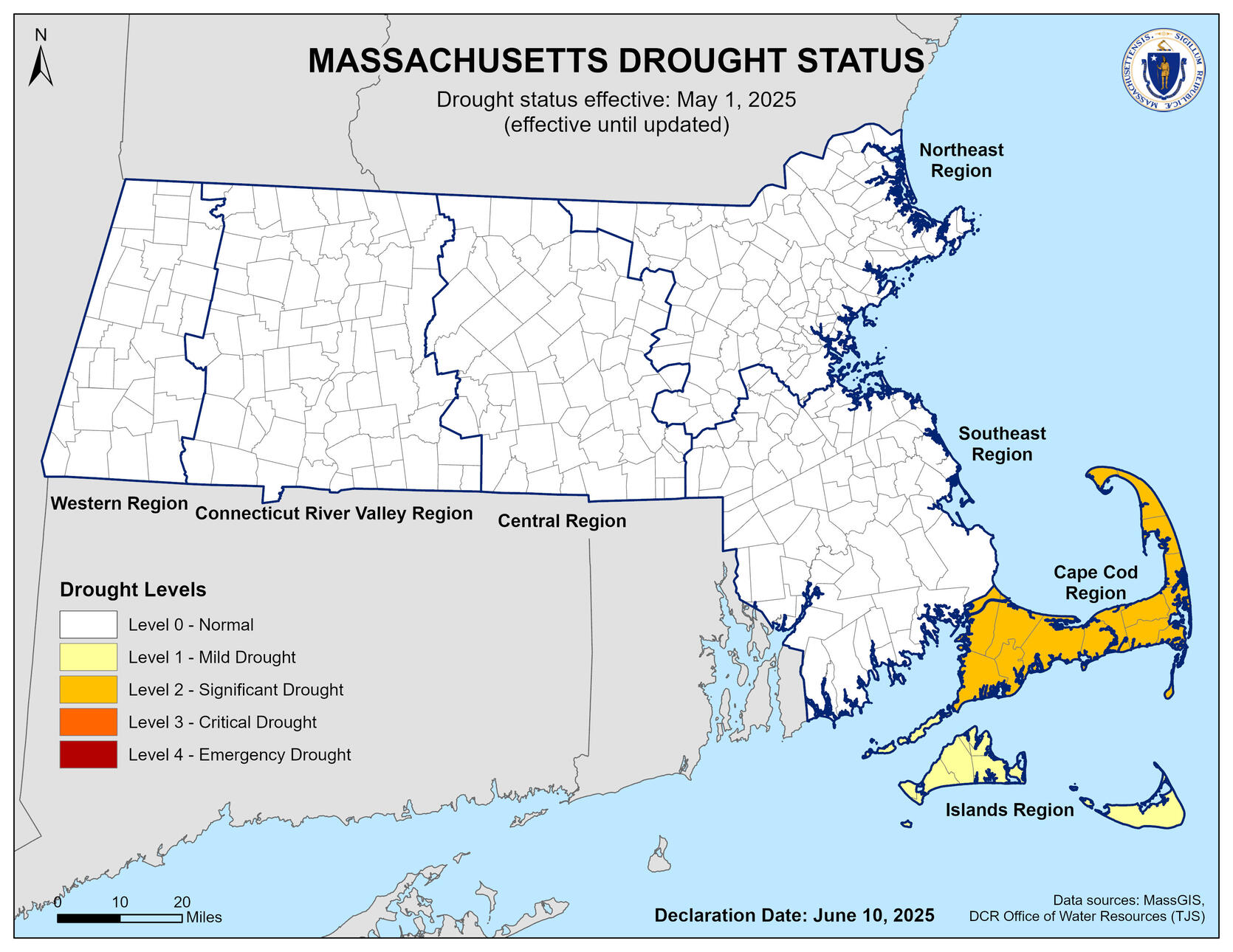- Executive Office of Energy and Environmental Affairs
- Drought Management Task Force
Media Contact
Aisha Revolus, Communications Manager

BOSTON — Today, Energy and Environmental Affairs (EEA) Secretary Rebecca Tepper declared theSoutheast Region has been downgraded to Level 0 – Normal Conditions, joining the Connecticut River Valley, Western, Central, and Northeast Regions. The Islands Region remains at Level 1 – Mild Drought, while the Cape Cod Region continues at Level 2 – Significant Drought.
Recent rains have provided relief, but more precipitation is still needed to restore water systems, particularly, groundwater levels in some parts of the state. As outlined in the Massachusetts Drought Management Plan, a Level 1 – Mild Drought and a Level – 2 Significant Drought require detailed monitoring of drought conditions. These levels also require ongoing coordination among state and federal agencies to implement drought response actions such as water use restrictions. Additionally, engagement with municipalities, including local Boards of Health, is essential. This includes providing technical outreach and assistance to water suppliers and affected municipalities.
“We are steadily approaching normal conditions in most of Massachusetts due to the recent rain,” said EEA Secretary Tepper. “As the weather warms up and the planting season is in full swing, it’s important to continue to be mindful of our water use to restore groundwater levels.”
During May, most of Massachusetts experienced above average precipitation. Several regions experienced rainfall amounts of 6 to 10 inches, exceeding normal levels by 2 to 6 inches. The Cape and Islands received less rainfall than the rest of the state - in the 3 to 6-inch range. Over the past three months, precipitation has been well above normal with recent rain improving streamflow and reducing fire risk across the state. However, drought conditions since last August continue to affect groundwater levels, which typically take longer to recover. Although some regions have recovered at the regional scale, there may be localized deficits in groundwater levels in a few areas that will take more time for full recovery.
The Drought Management Task Force (DMTF) collected data from August 2024 through May 2025. Residents can report dry environmental conditions and submit photos to help monitor the situation at Massachusetts Water Impact Reporting. Additionally, a FAQ is now available for questions regarding the current drought status and water conservation.
The Massachusetts Department of Environmental Protection (MassDEP) will continue to assist communities in managing their water systems. The Massachusetts Water Resources Authority (MWRA) water supply system is not experiencing drought conditions.
Below are recommendations for communities and individuals living and working within a Level 1 – Mild Drought and Level 2 – Significant Drought, including those utilizing a private well. Residents and businesses are also asked to check with their local water system in case more stringent watering restrictions are in place.
For Regions in Level 1 – Mild Drought
Residents and Businesses:
- Minimize overall water use;
- Limit outdoor watering to one day per week from 5:00 p.m. to 9:00 a.m., or less frequently if required by your water supplier;
- Plant only local and drought-resistant species;
- Fix indoor leaks, such as from toilets, faucets, and showers, which result in more than 60 percent of indoor use;
- For larger buildings and businesses, conduct water audits to identify areas of leaks and potential water conservation opportunities;
- Minimize lawn sizes; and,
- Harvest rainwater for outdoor watering.
Communities/Municipalities:
- Establish a year-round water conservation program that includes public education and communication, taking advantage of the state’s library of outreach materials;
- Provide timely drought and water conservation information to residents and businesses;
- Check emergency inter-connections for water supply; and,
- Develop a local drought management plan (learn more Drought Planning Guidance).
For Regions in Level 2 – Significant Drought
Residents and Businesses:
- Minimize overall water use;
- Limit outdoor watering to hand-held hoses or watering cans, to be used only after 5 p.m. or before 9 a.m.;
- Follow local water use restrictions;
- Fix indoor leaks, such as from toilets, faucets, and showers, which result in more than 60 percent of indoor use; and,
- For larger buildings and businesses, conduct water audits to identify areas of leaks and potential water conservation opportunities.
Immediate Steps for Communities/Municipalities:
- Adopt and implement the state’s nonessential outdoor water use restrictions for Drought Level 2 which calls for limiting outdoor watering to hand-held hoses or watering cans, to be used only after 5 p.m. or before 9 a.m. If local restrictions are more stringent, continue to keep them in place during the course of the drought.
- Limit or prohibit washing of hard surfaces (sidewalks, patios, driveways, siding); personal vehicle or boat washing; and,
- Establish water-use reduction targets for all water users, identify top water users and conduct targeted outreach to help curb their use.
Short- and Medium-Term Steps for Communities/Municipalities:
- Establish a year-round water conservation program that includes public education and communication, taking advantage of the state’s library of outreach materials;
- Provide timely information to local residents and businesses;
- Implement or establish drought surcharge or seasonal water rates;
- Check emergency inter-connections for water supply; and,
- Develop or refine your local drought management plan using guidance outlined in the state Drought Management Plan.
State agencies will continue to closely monitor and assess conditions across the state, coordinate any needed dissemination of information to the public, and help federal, state, and local agencies prepare additional responses that may be needed in the future. The Drought Management Task Force will meet again on Wednesday, July 9 at 10:00 am. For further information on water conservation and what residents can do, visit the EEA’s drought and water conservation pages.
###
